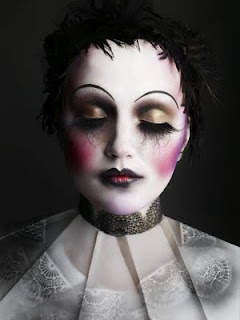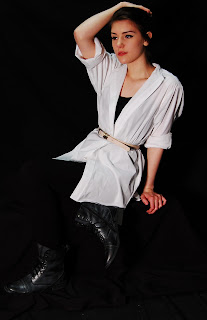Tuesday, 29 March 2011
Thursday, 24 March 2011
Alex Box
i had to do a written piece for my university interview so i discovered a make up artist Alex box her work is inspiring and inspirational.
Alex Box
Alex box is a lady that is creative in her makeup, she is the creative director of Illamasqua Cosmetics. The Magazines that she works for are Italian Vogue, Numero and Harper’s Bazaar. I feel that her makeup is extreme and I feel that she has her own personal style that is unique, she turns her makeup into an art piece, it attracts the eye and stands out so much that you want to keep looking at it, it also makes you wonder how it was created, it is a master piece. After looking at her work and researching about her work the tip that she gave was: “BOLDNESS OF ATTACK, LET YOUR MIND AND SPIRIT BE FREE, THERE ARE ‘NO RULES’, YOU ARE YOUR OWN CREATION”
After looking at all of her work the one that stood out to me the most was the one shown at the top of the page. This is one of my favourite pieces of work that Alex Box has created, I love the way that she has used light colours and natural ones, of different tones of browns. The wig that is used was based in the 18th century. I really like the black laced hair net used. The white base used, makes you drawn to look at her face first. The way she has used the pink and purple shades on the face makes her have a strong cheek line, I love how Alex box continues the colours on the eyelids and the lips, and the way she has used extended eyelashes makes the eyes bolder. The picture is taken straight on, but the model is looking down giving no form of eye contact, but she looks happy and content.
Illamasqua cosmetics are used for stage and screen make up, and currently is in the high street, the makeup is long lasting. This product has a great reputation as the products are not tested on animals. The colour’s in the brand is intense and has a huge range which makes you able to create and achieve a range of different looks. I have never used there make up brand but after all the research I have done I would love to try it and create my own unique styles using their brand.
Location shoot
Here are some pictures that i took on my locatuon shoot in oxford, i and going to experiment with them by cutting sections out and adding them on to other pictures and also layering them on top of each other and remving sections.
How to describe a photo.
When i looked online to help with what to say about a photo here is what i found:
Best Answer - Chosen by Voters
This website might be useful for you:
http://www.ego4u.com/en/cram-up/writing/…
First of all, it gives you some general information about picture description.
Then it provides the following word lists:
Kinds of pictures and perspectives:
viewer
picture, image
painting
photograph / photo
portrait
landscape painting
worm's eye view
bird's eye view
Structure:
foreground
background
in the upper part
in the lower part
in the left part
in the right part
in the central part
in front of
behind
next to …
on the right
on the left
in the middle
from front
from behind
from above
from below
the second from left/right
Others:
artificial light
daylight
subdued light
light colours
dark colours
loud colours
contrasty
vanishing point
vanishing line
Information on artist and year of origin:
… (image) is a painting by … (artist), painted in … (year).
… (image), painted in … (year), is a work by … (artist)
… (artist) painted … (image) in … (year).
… (image) is a famous painting by … (artist).
Describing the scene
The picture was taken in … (place).
The photo was taken at … (party).
The picture shows a scene from …
It's an image of … (place, person, scene).
The picture describes … (scene).
The picture shows … (place, person, scene) from a distance.
… (place, person, scene) is shown from … (a bird's eye view/…).
You look at … (place, person, scene) from … (above/behind/…).
What can you see?:
In the picture you can see …
… (position: on the left/right/…) there is / are …
… (position: on the left/right/…) you can see …
… is … (position: on the left/right/…)
Impression:
… gives the impression of depth.
… (person) seems to look at the viewer.
His / Her eyes seem to follow the viewer.
The figures look as if they exist in three dimensions.
The viewer has the impression that the people in the picture are alive.
The viewer's attention is focused on …
To the alert eye it will become apparent …
The viewer finds it difficult to withdraw his eyes from …
The painting is vivid / happy / expressive.
The picture makes the viewer feel … (sad/happy)
The picture inspires the viewer to think about …
Intention:
The artist mainly uses … (colours/forms/…)
Important elements are highlighted.
The artist / photographer / painter uses … to express …
He / She (probably) wants to criticise / express / show …
It is obvious that the artist wants to criticise / express / show …
What the artist / photographer / painter wants to criticise / express / show is …
What the artist / photographer / painter wants to point out is …:
I think / believe / am sure that …
It seems / appears to me that …
The problem illustrated here is …
… symbolises …
… is typical of …Picture Description
http://www.ego4u.com/en/cram-up/writing/…
First of all, it gives you some general information about picture description.
Then it provides the following word lists:
Kinds of pictures and perspectives:
viewer
picture, image
painting
photograph / photo
portrait
landscape painting
worm's eye view
bird's eye view
Structure:
foreground
background
in the upper part
in the lower part
in the left part
in the right part
in the central part
in front of
behind
next to …
on the right
on the left
in the middle
from front
from behind
from above
from below
the second from left/right
Others:
artificial light
daylight
subdued light
light colours
dark colours
loud colours
contrasty
vanishing point
vanishing line
Information on artist and year of origin:
… (image) is a painting by … (artist), painted in … (year).
… (image), painted in … (year), is a work by … (artist)
… (artist) painted … (image) in … (year).
… (image) is a famous painting by … (artist).
Describing the scene
The picture was taken in … (place).
The photo was taken at … (party).
The picture shows a scene from …
It's an image of … (place, person, scene).
The picture describes … (scene).
The picture shows … (place, person, scene) from a distance.
… (place, person, scene) is shown from … (a bird's eye view/…).
You look at … (place, person, scene) from … (above/behind/…).
What can you see?:
In the picture you can see …
… (position: on the left/right/…) there is / are …
… (position: on the left/right/…) you can see …
… is … (position: on the left/right/…)
Impression:
… gives the impression of depth.
… (person) seems to look at the viewer.
His / Her eyes seem to follow the viewer.
The figures look as if they exist in three dimensions.
The viewer has the impression that the people in the picture are alive.
The viewer's attention is focused on …
To the alert eye it will become apparent …
The viewer finds it difficult to withdraw his eyes from …
The painting is vivid / happy / expressive.
The picture makes the viewer feel … (sad/happy)
The picture inspires the viewer to think about …
Intention:
The artist mainly uses … (colours/forms/…)
Important elements are highlighted.
The artist / photographer / painter uses … to express …
He / She (probably) wants to criticise / express / show …
It is obvious that the artist wants to criticise / express / show …
What the artist / photographer / painter wants to criticise / express / show is …
What the artist / photographer / painter wants to point out is …:
I think / believe / am sure that …
It seems / appears to me that …
The problem illustrated here is …
… symbolises …
… is typical of …Picture Description
Reason
A picture description is an ideal way of practising your English vocabulary in all sorts of fields. And there's also a benefit for everyday life – imagine you want to show pictures of your family or home to your foreign friends.
Describing paintings or other art pictures (e. g. caricatures) is something for the advanced learner of English as you also have to talk about the artists intention and the impression on the viewer.
Preparation
Have a close look at the picture and decide on how to structure your picture description. What is important or special? What should the viewer pay attention to?
Structure and Content
It's not easy to follow a picture description if the writer jumps randomly from one point to another. Therefore, make sure that your picture description is logically structured, for example:
§ from left to right (or from right to left)
§ from the background to the foreground (or from the foreground to the background)
§ from the middle to the sides (or from the sides to the middle)
§ from details to general impressions (or from general impressions to details)
Which structure you finally choose depends on your taste and the picture you want to describe.
Pictures in General
§ short description of the scene (e. g. place, event)
§ details (who / what can you see)
§ background information (if necessary) on place, important persons or event
Paintings
§ name of artist and picture, year of origin (if known)
§ short description of the scene (e. g. place, event)
§ details (who / what can you see)
§ impression on the viewer
§ artist's intention
Subscribe to:
Posts (Atom)














